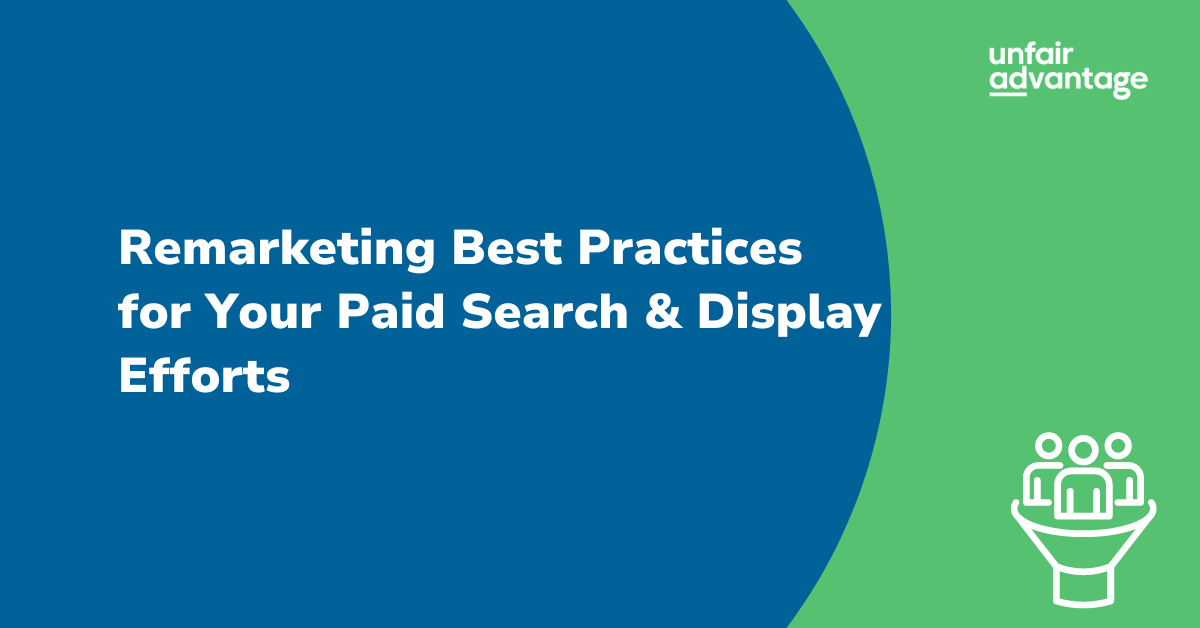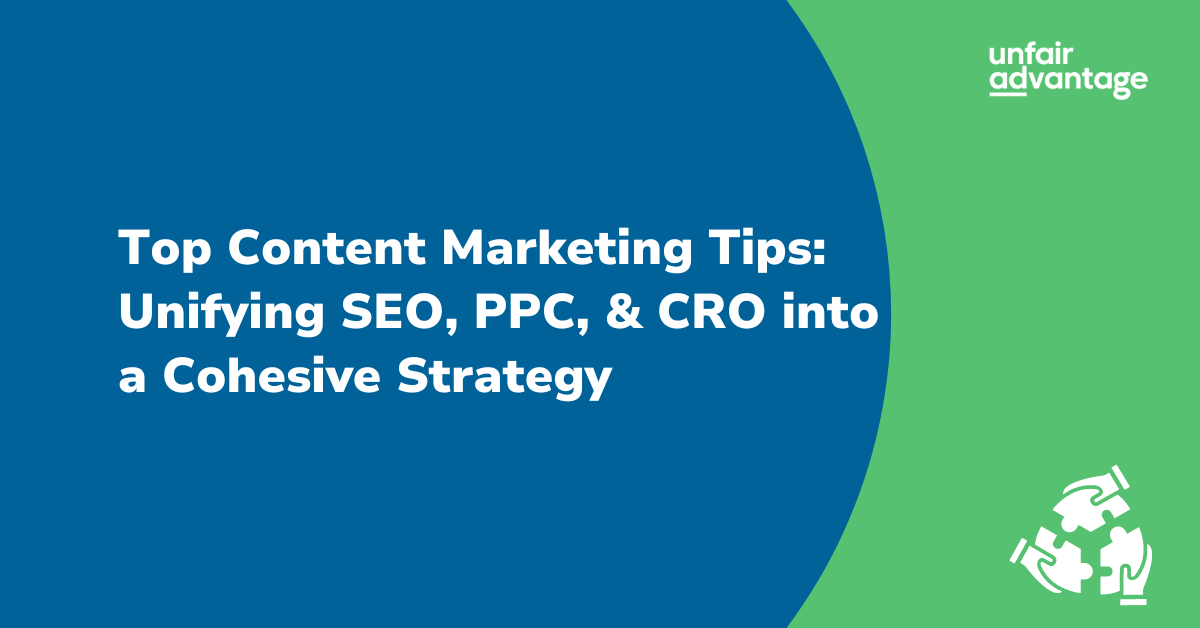
The Complete Digital Marketing Checklist
The Ultimate Digital Marketing Checklist for Large and Small Businesses
As you know, the digital marketing landscape is vast and not one size fits all. Whether you’re a small business or a large enterprise, it can be overwhelming to ensure you’ve covered all the bases for your digital marketing strategy.
The team at Unfair Advantage wanted to provide The Ultimate digital marketing checklist to help you feel confident that your focus is on what matters most, no matter the size of your business or expertise level.
Why You Should Always Use a Digital Marketing Checklist
Since it can be difficult to know where to start, the below checklist is meant to guide you through the process of launching a successful digital marketing strategy. From setting goals for your business to ensuring your website is conversion ready, we will go through the many things to consider so you can “check” it off your list.
This checklist as well as our Marketing Tips for Beginners are based on our experts’ collected years of experience in the digital marketing landscape and the best practices and learnings we picked up along the way (we have been going at this since 2008!). Let’s dive in!
Set Your Marketing Goals
The first step before you go any further should be to understand the “why” – why are you marketing? How do your marketing goals tie into your business goals? More specifically, how can digital marketing help you reach those goals?
As you work on your goals, you want them to be first, realistic and second, achievable. When identifying your specific marketing goals make sure they are SMART goals. SMART goals provide a structured guideline to ensure your goals are Specific, Measurable, Actionable, Realistic, and Timebound. Your marketing goals should help support your business’ long-term goals through this structure.
Verify Your Marketing Budget
So now that you know what you want to accomplish through SMART goals, what resources are available to you to do so? Think about this beyond money or marketing budgets, consider your time and your team as valuable resources, too. Do you or your team have the time/expertise to dedicate to execute these marketing plans?
Now that you know what resources you have, are your goals still reasonable or do they need to be updated?
Identify What Content Your Target Audience Needs
Content is king in the digital marketing landscape, it’s what drives users and action to and through your site across all different engagements. Planning out a thoughtful and strategic content strategy will help streamline content creation.
Think about what type of content your current audience and target market would find beneficial, what would help to solve their problems, what would be engaging, what do people want or need to know? Consider what you already have as well as what you need to create: you don’t need to reinvent the wheel, but you also don’t want to leave up a bad landing page just because it’s already done.
Determine What Strategies You Want to Use
Now is the time to start refining what strategies you want to use and focus on in your digital marketing plan. Do you want to use digital ads, website, email, social media, and/or influencer marketing?
How do your digital marketing plans integrate with other marketing efforts (print or radio, for example)? What resources are needed for that? Planning these out and what’s needed to support these strategies can help flesh out your marketing plan and actionable items.
Create A Realistic Digital Marketing Plan
Now you have goals, a budget, and a general idea of where to focus, it’s time to put it all together into a plan. Navigating the digital marketing landscape without a compass is nearly impossible. Using your plan helps focus your strategy, define common goals to work towards, and helps everyone stay on course toward one shared objective. This can look like…
- Mission Statement
- Marketing Objectives
- Marketing Strategy
- Budget
- Specific Tactics
- Etc.
Evaluate Your Competition
It’s important to keep your competitors in mind during this process. Knowing who your competitors are not just from a business standpoint but also a marketing standpoint. What are they doing? If they are doing paid search, you probably should, too. Where are they absent? If they don’t do organic social, you can own that space. Thinking of ways to level up and stand out will be an important pillar of your digital marketing plan.
In addition to identifying who your competitors are, you should also be thinking of how you differ – what key value propositions do you offer that your competitors do not? How can you use this to your advantage?
Choose Your Online Marketing Channels
Based on all the above information, you can start to choose the channels that you will run on. Yes, there are a lot of options (search, social, display, shopping, video…just to name a few).
Here’s the good news: you can take a rolling launch approach! We always come back to the saying “Test, test, and test again.” Think of a few key channels you want to start with – insider tip: some audience research can go a long way here. Where is the bulk of your audience right now?
Determine The Tools You Need to Run Your Campaigns
Now that you know your channels, what tools do you need?
- Keyword research
- Google/Microsoft Ads editor
- Hotjar (heatmaps and scroll behavior on site)
- Google Analytics
- Google Optimize
- Screaming Frog
- Ahrefs
- The list goes on!
Create Business Pages on All Available Social Media Networks
If you are considering organic social, don’t just focus on one. People search in a variety of ways and each platform reaches a different audience. Think about ways to repurpose content between each platform if resources are limited. For example, a TikTok video can be posted to Facebook, Instagram, YouTube, and Twitter.
Your business pages on social media are all about your brand and the services/products you offer. Building your page up on each social media channel will be crucial for building brand loyalty and trust.
Want to know more about how to advertise on specific social media channels? Check out our tips on advertising on Twitter , Facebook paid strategies , and LinkedIn ads if you want to dive deeper into social media advertising.
Evaluate Your Website’s Performance
As you begin it’s important to have a baseline. Understanding where your website is now (how many people are getting to your site, conversion rate, time on site, etc.) will help you measure success against this benchmark as you grow and expand through your digital strategy.
Review Your Website Design
In today’s marketing, your website is crucial. Determine the current health of your site, does the site load quickly? Is the text easy to read? Does the navigation make sense? How does it look on mobile devices? Are users getting to the end goal as expected or are there areas of friction?
What do you need to do to improve your site and its conversion rate and what resources do you have to get that done? Even a small lift in conversion rate has a huge impact on the bottom line, so making sure your site is as user-friendly as possible is very important.
Match Content with Each Stage of The Customer Journey
When thinking about content, think about your customer at all stages of their purchasing journey. When just starting out, what questions will they ask? Once they have searched for a few minutes, what are their lingering, more advanced questions? When ready to buy, how do they evaluate competitors against each other?
Do you have resources available to support these different stages of a user’s journey on your site?
Perform An SEO Audit
Performing an SEO audit on your site will be critical in spotting any issues ahead of time that could result in low organic performance. Some questions to ask yourself during this audit:
- Are any pages broken?
- Do the links on your key pages all work?
- Is it clear what the purpose of each page is?
- Have you considered what keywords you are targeting with each page, and are those worked into the page headings and body copy naturally?
- Do your images have alt tags and file names that include target keywords?
- What content do competitors have that you don’t?
Read more about how to get started with SEO here or contact us if you want a free digital marketing audit.
Engaging Landing Pages
If doing paid search, paid social, or email marketing, user experience on the page you direct them to via your ads or emails is critical – not just for UX (user experience) and conversion rate but in paid search it also affects how often Google will show your ad. You want to ensure the page you are sending users to answers any questions they may have as well as leading them down your preferred conversion path.
With organic traffic, you also want your top trafficked pages to provide a good user experience – once you’ve gotten users on your site, how are you moving them down the funnel and keeping them hooked with a seamless page experience?
Create A Strong Brand Identity
Whether through your website copy, social pages, or other channels, your brand identity needs to be cohesive across all properties. For example, banner images on social platforms should mimic your website with the same color schemes, font, design elements, messaging, etc. Transitioning from an ad to your site should feel seamless and aid in creating a strong brand presence for someone (whether they are new to the brand or already familiar with it).
Optimize Your Website for Conversions
It should be very obvious on every page what the user should do next. Stick to a single, clear call-to-action (CTA) and place it prominently on the page. You want to ensure valuable information is above the fold – eye tracking studies have shown that 80% of users’ viewing time is spent above the fold so be sure form fills, CTAs, and other valuable information that defines your product/offering is visible to users the second they land on your page.
Other key things to consider also include limiting the length of lead forms or steps in the checkout process to reduce bounce rate as well as telling users exactly what to expect when they land on each page.
Publish Thorough Content Based on Research or Statistical Analysis
Don’t post just for the sake of posting – put thought into your content. Look at competitors, look at your top performing content – what can you learn? What works and what doesn’t? What are the questions your users have? Answer them thoroughly and accurately. Creating a content calendar and ensuring you are analyzing and testing different things will help you learn what works best to drive results.
Go Back and Update Your Existing Content
Just as important as fresh, new content is making sure your past content doesn’t grow stale or, worse, inaccurate. Regularly review your oldest pages/posts to make sure they are still on brand and accurate. Regularly updating content on site (as well as posting new content on a consistent schedule) sends positive signals to Google and can over time help improve SEO.
What If You Need Help?
We understand that digital marketing can be daunting, whether it’s just you or you have a team to manage: this is exactly why digital marketing agencies exist! Effective digital marketing is complex and requires time, dedication, and money.
If you are new to digital marketing, or are looking to level up your efforts, we’re here to help! Unfair Advantage specializes in helping businesses that are smaller or are newer to digital marketing, contact us today!


